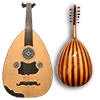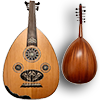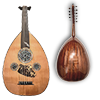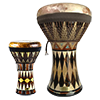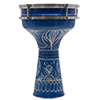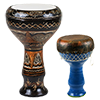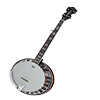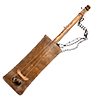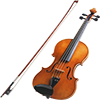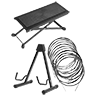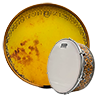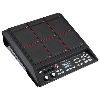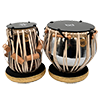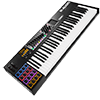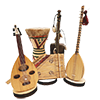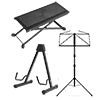All about the Oud
The Oud instrument (written “ud” in Turkish) is the ancestor of the European lute, whose name derives from “al-ud”. It is not a native Turkish instrument but has been played in Anatolia for at least five centuries. Moreover, in history, the oud has been played by several civilizations in Central Asia, Mesopotamia, Iran, Arabia. Accordingly, there are several types of oud besides the Turkish oud.
History of Oud
In some sources Farabi is said to have invented the oud, but long before Farabi there are ouds and similar instruments in miniature and relief. The main reason why Farabi is seen as an inventor is that he is a musician who masters the oud and the tuning system he brought to the oud. Farabi, who was one of those who gave the most complete information on the oud in his time, added the 5th string to the oud, which until then had been a 4-stringed instrument.
The neck frets of the oud, preserved in the Farabi period, were abandoned towards the end of the 10th century. The oud was previously played with a wooden plectrum. The famous Andalusian musician Ziryab (11th century) replaced it with an eagle feather plectrum. Today, picks are generally used (put plectrum link) in flexible plastic.
The oud instrument made its way to Europe through Spain. In the 13th century, the Crusaders brought it back to Europe, and over time it became the lute. This is why the lute takes its name from the oud ("the ut" in Old French), but has added features different from the oud, such as the frets.
The oud instrument has a large sound box connected to a short neck. The instrument has a pear-shaped body which is a deep, striped bowl of light wood. The wood should be light because the bowl is supposed to resonate when struck. The soundboard, the front part of the body, contains one or two, sometimes three soundholes. These sound holes can be oval or ornate depending on the spots they are played on. There is a piece of fish skin or leather between the bridge and the rosette to protect the belly from plectrum blows. The bowl of the oud is shaped by thin woods or ribs bent over a mould. The number of ribs varies from 16 to 21. The pegs of the oud are screwed to the pegbox.
The quality of the material used in making the oud is important. The more diverse the material, the better it sounds. The face of a high quality oud is made from spruce. The tuning pegs and fingerboard are made of ebony. Maple, walnut, rosewood and mahogany are used for the bowl.
The oud does not have a standard size or number of strings. Yet, in general, all types of ouds have 11 gut strings which are arranged in five double rows with a single bass sixth string. Its fretless neck allows the instrument to generate all the intervals or microtones specific to Middle Eastern music. Oud instrument allows you to enjoy Turkish, Iranian or Arabic music by playing makams/maqamat.
The Oud is played according to two schools of performance. The first is the “Ottoman” school and it retains as its principle the ornamentation of sound, produced by delicate glissandos or fingers and light vibratos. The second approach is the Egyptian approach, where the volume is boosted by firm strokes of the plectrum, causing the strings to resonate. This style requires another form of virtuosity.
There are basically six types of oud when considered according to their origin. These types of oud mainly differ in timbre and there are small differences in size between them.
The Arabic oud is the best known and perhaps the most popular type of oud instrument due to its romantic, rich and deep sound. It is heavier and slightly larger than Turkish ouds. Turkish ouds are used in Turkey and Greece. They have a higher pitched sound. The Syrian oud which is a subtype of Arabic oud, generates a lot of harmonics. Iraqi ouds can also be classified under Arabic ouds. Its strings are attached to the bottom of the instrument. Because of this feature, it is said to have a pontoon bridge. The Iranian oud, also called Barbat, is more distinct and due to its shape has a low and deep Persian sound.
How to play the oud?
You must start with tuning, as in almost all musical instruments to play the oud instrument. Tuner and pegs available on oud instruments are used for the tuning process. We need to use the upper strings to tune the right strings and the lower strings to tune the left strings.
The string names of the oud are also in order from bottom to top. In this order, the lowest string shows the G note. The next D note, the next F, the next E, then the B, and finally the A note.
The Structure of Oud
The body of Arabic ouds is usually slightly larger. In Turkish and Arabic, Iranian, Armenian and Greek ouds, these circular chest holes are decorated with roses. The Oud retained its current structure for almost a thousand years except for a few minor modifications.
20 large crescent-shaped slices of wood form the large pear-shaped body of the instrument. The short, flat handle is fixed to the body by a wedge. The width of the handle, which tapers towards the screw, is about four fingers wide at the junction of the body. The auger, which makes an angle of approximately 45° with the handle, draws an indistinct S and the augers enter it from the side. Each wire comes out of the wire wedge directly glued to the trunk, wraps around its own auger overcoming the head sill at the junction of the handle.
The chest of the oud is a uniform fibrous sheet of spruce wood, about 1 mm thick. The slats that support the chest from below are called "balconies". The layout of the balconies is closely linked to the sound of the instrument.
Setting
There are many ways to tune the oud instrument. The differences noted vary according to the traditions of the place where the instrument was produced.
Among those who play the oud in the Arabic tradition, a common older pattern of string tuning is (low to high): D2 G2 A2 D3 G3 C4 on single string courses or D2, G2 G2, A2 A2, D3 D3, G3 G3 , C4 C4 for a two-string course.
In the Turkish tradition, the "Bolahenk" tuning, is common in general, (low to high): C#2 F#2 B2 E3 A3 D4 on single string instruments or C#2, F#2 F#2 , B2 B2, E3 E3, A3 A3, D4 D4 on instruments with two strings. C2 and F2 are actually tuned 1/4 tone higher than a normal C or F in the Bolahenk system.
Many current Arabic players use this tuning: C2 F2 A2 D3 G3 C4 on standard tuning instruments, and some use a higher tuning, FADGCF




